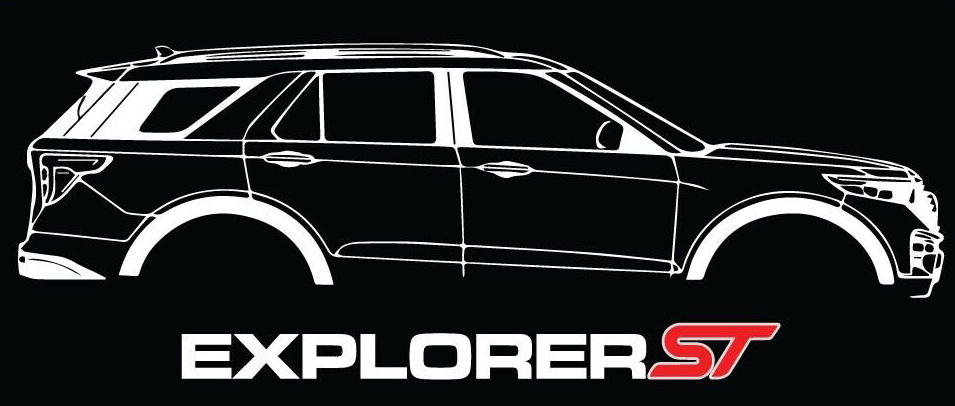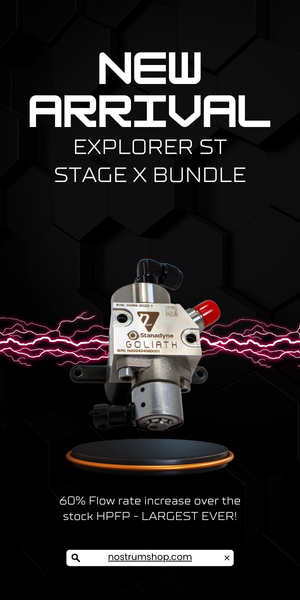The Dodge Hellcat is an American muscle car icon, packing 707+ horsepower and a supercharged 6.2L V8, making it one of the fastest production vehicles on the road. Meanwhile, the Ford Explorer ST, a three-row performance SUV, might not seem like a fair competitor—at least in stock form. However, recent races, including the viral video of an Explorer ST going head-to-head with a Hellcat, have shown that with the right modifications, the Explorer ST can close the gap—and even pull ahead in certain scenarios.
So, what does it take to make an Explorer ST fast enough to beat a Hellcat? In this guide, we’ll cover the key modifications needed, including power upgrades, weight reduction, tuning, and drivetrain enhancements.
1. Start with a Performance Tune
Why It’s Important:
The stock Explorer ST comes with 400 horsepower and 415 lb-ft of torque, but Ford leaves a lot of power on the table. A performance ECU tune can unlock significant gains, optimizing boost pressure, ignition timing, and fuel delivery to maximize performance.
Recommended Tunes:
-
Livernois Motorsports MyCalibrator Tune (+70-100 HP)
-
ZFG Racing Stage 1 & Stage 2 Tunes (+80-120 HP)
-
Palm Beach Dyno Custom Tune (varies based on modifications)
Expected Gains:
🔹 +80-120 HP with a proper tune
🔹 Faster throttle response and better power delivery
🔹 Higher boost levels from factory turbos
2. Upgrade the Intake System
Why It’s Important:
The factory intake on the Explorer ST is restrictive, limiting airflow to the twin-turbo 3.0L EcoBoost engine. A high-performance cold air intake (CAI) allows for better airflow, improving turbo efficiency and throttle response.
Best Cold Air Intakes for Explorer ST:
-
aFe Momentum GT Cold Air Intake
-
S&B Cold Air Intake
-
JLT Performance Intake
-
Mishimoto Performance Intake
Expected Gains:
🔹 +10-20 HP with a high-flow intake
🔹 Better turbo spool and throttle response
🔹 More aggressive turbo sound
3. Install a Front Mount Intercooler (FMIC)
Why It’s Important:
The stock intercooler heats up quickly under high boost, leading to heat soak and power loss. A larger, more efficient intercooler helps maintain cooler intake temperatures, keeping the engine performing consistently at high speeds.
Best Intercoolers for Explorer ST:
-
Mishimoto Performance Intercooler
-
CVF Titan Intercooler
-
Whipple Front Mounted Megacooler Intercooler
Expected Gains:
🔹 More consistent power under high boost
🔹 Reduced heat soak for better performance
🔹 Slight horsepower gains (+10-20 HP)
4. Upgrade the Exhaust System
Why It’s Important:
The factory exhaust system is restrictive, limiting power and efficiency. An aftermarket downpipe and cat-back exhaust will allow the engine to breathe better, reducing backpressure and improving turbo efficiency.
Best Exhaust Upgrades for Explorer ST:
-
SPD Performance Catted or Catless Downpipes
-
MBRP or Borla Cat-Back Exhaust Systems
-
Custom Full Turbo-Back Exhaust
Expected Gains:
🔹 +20-50 HP with high-flow downpipes and exhaust
🔹 Deeper, more aggressive exhaust note
🔹 Faster turbo spool
5. Upgrade to Larger Turbos
Why It’s Important:
The stock turbos on the Explorer ST are efficient but small. If you want to make Hellcat-level power, upgrading to larger turbochargers is essential. Bigger turbos allow for more airflow, higher boost levels, and greater horsepower gains.
Best Turbo Upgrades for Explorer ST:
-
CR Performance Stage 3 Turbos (700+ HP capable)
-
Garrett PowerMax Turbo Upgrade
-
ZFG Racing Turbo Upgrades
Expected Gains:
🔹 +100-200 HP depending on turbo size
🔹 Significantly increased top-end power
🔹 More aggressive boost response
6. Optimize Fueling with Upgraded Injectors & Ethanol (E85) Tune
Why It’s Important:
The Explorer ST’s stock fuel system is designed for pump gas (91/93 octane), but switching to E85 or a methanol injection kit allows for higher boost, more timing advance, and increased power potential.
Best Fueling Upgrades for Explorer ST:
-
Larger fuel injectors (like ID1050X)
-
High-flow fuel pump upgrade
-
Ethanol flex-fuel tuning (E30/E50 blends recommended)
-
Snow Performance or AEM Methanol Injection Kits
Expected Gains:
🔹 +50-100 HP with E85 and upgraded injectors
🔹 Lower intake temps for better performance
🔹 Higher boost potential without knock
7. Transmission Upgrades & Drivetrain Reinforcements
Why It’s Important:
The 10-speed automatic transmission in the Explorer ST is strong but not invincible. Once power levels exceed 600+ HP, upgrading the transmission tuning and supporting components is essential.
Best Transmission & Drivetrain Upgrades:
-
HP Tuners or ZFG Racing Transmission Tune
-
Upgraded torque converter
-
Stronger driveshaft and axles (DSS upgrades)
-
High-performance transmission cooler
Expected Gains:
🔹 Faster, firmer shifts
🔹 Improved launch performance
🔹 Better reliability at high power levels
8. Suspension & Tires for Maximum Grip
Why It’s Important:
Beating a Hellcat isn’t just about power—it’s also about traction. A well-sorted suspension and high-performance tires will ensure the Explorer ST puts power to the ground effectively.
Best Suspension & Tire Upgrades:
-
H&R Lowering Springs or KW Coilovers
-
Upgraded sway bars & strut braces
-
Michelin Pilot Sport 4S or Nitto NT555R Drag Radials
Expected Gains:
🔹 Improved stability at high speeds
🔹 Better weight transfer on launch
🔹 More predictable handling
Final Build Summary: Beating a Hellcat with an Explorer ST
| Modification | Estimated HP Gains |
|---|---|
| ECU Tune | +80-120 HP |
| Cold Air Intake | +10-20 HP |
| Bigger Turbos | +100-200 HP |
| Exhaust System | +20-50 HP |
| Intercooler | +10-20 HP |
| E85 Tune & Injectors | +50-100 HP |
| Transmission Tune | Faster Shifts |
| Suspension & Tires | Better Traction |
Total Potential Power: 650-750 HP
With 700+ HP, AWD traction, and the right modifications, a built Explorer ST can absolutely take down a Dodge Hellcat in a roll race or even in a drag race with proper launching techniques. The key is maximizing turbo efficiency, fuel delivery, and drivetrain reliability.
Would you build your Explorer ST to beat a Hellcat? Let us know in the comments!




